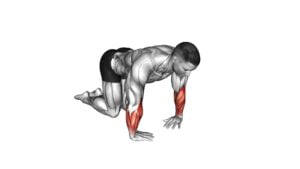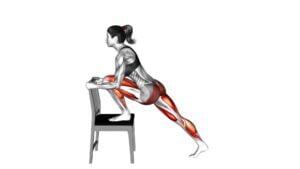Wrist Ulnar Deviator And Flexor Stretch (female) – Video Exercise Guide & Tips

Are you looking for an effective wrist stretch to improve flexibility and strength? Look no further than the Wrist Ulnar Deviator and Flexor Stretch.
Watch This Exercise Video
This video exercise guide will walk you through the proper execution of this stretch, providing step-by-step instructions and variations for different fitness levels.
Avoid common mistakes and learn how to incorporate this stretch into your workout routine for maximum benefits.
Get ready to improve your wrist mobility with this informative and precise exercise guide.
Key Takeaways
- Listening to your body is crucial for preventing injuries during exercise
- Improper stretching techniques can increase the risk of injuries
- The wrist ulnar deviator and flexor stretch improves wrist flexibility
- Gradually increase the intensity and duration of the stretch over time
Benefits of the Wrist Ulnar Deviator and Flexor Stretch
The wrist ulnar deviator and flexor stretch provides a range of benefits for you. One of the key benefits is the importance of wrist flexibility. By regularly performing this stretch, you can improve the flexibility and range of motion in your wrists, which is essential for many daily activities and exercises. Flexible wrists allow for better grip strength, improved performance in sports that involve wrist movements, and reduced risk of wrist injuries.
However, it's important to take precautions when performing wrist stretches. First, make sure to warm up your wrists before starting the stretch to prevent any potential injuries. Also, be gentle and avoid any sudden or jerky movements during the stretch. Start with a light stretch and gradually increase the intensity as your wrists become more flexible over time. If you experience any pain or discomfort during the stretch, stop immediately and consult a healthcare professional.
In the following section, we'll provide you with step-by-step instructions for proper execution of the wrist ulnar deviator and flexor stretch. By following these instructions carefully, you can maximize the benefits of this stretch while minimizing the risk of injury.
Step-by-Step Instructions for Proper Execution
To properly execute the wrist ulnar deviator and flexor stretch, begin by positioning yourself in a comfortable seated position. Here are the step-by-step instructions for performing this exercise:
- Sit on a chair or a mat with your back straight and your feet flat on the floor.
- Extend your right arm in front of you, palm facing down.
- Use your left hand to grasp your right hand, placing your fingers on the back of your hand and your thumb on the palm side.
- Gently pull your right hand towards your body, feeling a stretch in your wrist and forearm.
- Hold the stretch for 15-30 seconds, while maintaining a relaxed breathing pattern.
Repeat the stretch on the other side, switching hands and positioning your left arm in front of you. Perform 2-3 sets of 10-15 repetitions on each side, depending on your comfort level and flexibility.
As you progress, you can increase the duration of the stretch or use a resistance band for added difficulty. No equipment is needed for this exercise, making it convenient to perform anywhere.
Modifications and Variations for Different Fitness Levels
To adjust this exercise for different fitness levels, you can modify the intensity by applying more or less pressure when pulling the hand towards the body, depending on your level of comfort and flexibility. This allows you to gradually progress and challenge yourself as you become more proficient in the exercise.
For beginners or individuals with limited flexibility, it's recommended to start with lighter pressure and gradually increase it as you feel more comfortable. This will help prevent any strain or discomfort in the wrist and forearm. As you become more advanced, you can apply more pressure to enhance the stretch and increase the difficulty of the exercise.
Equipment modifications can also be made to accommodate different fitness levels. For individuals with limited flexibility, using a resistance band or towel can provide additional support and assistance in pulling the hand towards the body. This allows for a gentler stretch while still targeting the wrist and forearm muscles. On the other hand, advanced individuals can use a heavier resistance band or even dumbbells to increase the resistance and intensify the stretch.
Remember to listen to your body and only push yourself within your limits. It's important to find the right balance between challenge and comfort to ensure safe and effective progression in your fitness journey.
Common Mistakes to Avoid During the Stretch
When performing the wrist ulnar deviator and flexor stretch, it's important to be aware of common mistakes to avoid during the exercise. Proper execution is crucial to prevent injury and maximize the effectiveness of the stretch. Here are some common mistakes to watch out for:
- Incorrect hand positioning: Make sure your hand is in the correct position before starting the stretch. Your palm should be facing up, and your fingers should be pointing towards your body. This will target the ulnar deviators and flexors effectively.
- Using excessive force: Avoid applying excessive force while performing the stretch. It's important to maintain a gentle and controlled movement to prevent strain or injury to the wrist.
- Neglecting the proper form: Pay attention to your form throughout the stretch. Keep your wrist straight and avoid bending it excessively. Maintain good posture and engage your core for stability.
- Rushing through the exercise: Take your time and perform the stretch slowly and with control. Rushing through the exercise can lead to poor form and reduced effectiveness. Focus on the stretch and feel the tension in your wrist muscles.
Tips for Incorporating the Stretch Into Your Workout Routine
To effectively incorporate the wrist ulnar deviator and flexor stretch into your workout routine, focus on proper form and gradually increase the intensity of the stretch. It's important to take precautions and follow safety measures to prevent any potential injuries.
Before performing the stretch, make sure your wrist is warmed up and flexible. You can do this by gently rotating your wrist in circular motions and stretching it in different directions. When performing the stretch, remember to keep your arm straight and your hand relaxed. Slowly bend your wrist towards your little finger side until you feel a gentle stretch in your forearm. Hold this position for 15-30 seconds, without bouncing or forcing the stretch. Repeat the stretch on both wrists for a balanced workout.
Incorporating the wrist ulnar deviator and flexor stretch into your workout routine can be done 2-3 times a week. Start with 1 set of 2-3 repetitions and gradually increase the number of sets as your flexibility improves. Each repetition should be performed with control and without any pain. It's important to listen to your body and not push beyond your limits.
If you experience any discomfort or pain during the stretch, stop immediately and consult with a healthcare professional. By following these guidelines and incorporating the wrist ulnar deviator and flexor stretch into your workout routine, you can improve wrist flexibility and prevent potential injuries.
Frequently Asked Questions
How Many Times a Week Should I Perform the Wrist Ulnar Deviator and Flexor Stretch?
To effectively stretch your wrist ulnar deviator and flexor muscles, you should perform this exercise a few times a week. By incorporating this stretch into your routine, you can improve flexibility and reduce the risk of injury.
Remember to listen to your body and start with a comfortable range of motion. Gradually increase the intensity and duration of the stretch as you progress.
Consistency is key for maximizing the benefits of these effective wrist stretching techniques.
Can I Perform This Stretch if I Have a Wrist Injury?
If you have a wrist injury, it's important to modify your stretches to avoid further damage. The Wrist Ulnar Deviator and Flexor Stretch may not be suitable for you in this case.
Instead, consider alternative stretches that are gentle on the wrist, such as wrist rotations or forearm stretches.
It's always best to consult with a healthcare professional or physical therapist for personalized advice based on your specific injury.
Is It Normal to Feel Discomfort During the Stretch?
Yes, it's normal to feel some discomfort during the wrist ulnar deviator and flexor stretch. This stretch targets the muscles in your wrist and forearm, so it's common to experience a mild stretching sensation or tightness.
However, if you feel sharp or intense pain, you should stop immediately and consult with a healthcare professional. Remember to listen to your body and adjust the intensity of the stretch as needed.
Can I Use a Resistance Band to Enhance the Stretch?
Yes, you can definitely use a resistance band to enhance the stretch. Using a resistance band can provide additional resistance and help to increase the intensity of the stretch, allowing for greater flexibility and strength gains.
However, it's important to use the band properly and gradually increase the tension to avoid overstretching or injury.
If you prefer an alternative stretch, there are other exercises you can try that target the same muscles and provide similar benefits.
Are There Any Specific Warm-Up Exercises I Should Do Before Performing This Stretch?
Before performing the wrist ulnar deviator and flexor stretch, it's important to warm up your wrists with specific exercises.
Wrist mobility exercises can help prepare your wrists for the stretch and minimize the risk of injury. These exercises can include wrist circles, wrist extensions, and wrist flexions.
Conclusion
Incorporating the wrist ulnar deviator and flexor stretch into your workout routine can provide numerous benefits. This exercise helps improve wrist flexibility, strength, and range of motion.
By following the step-by-step instructions and avoiding common mistakes, you can safely and effectively perform this stretch. Whether you're a beginner or advanced fitness enthusiast, modifications and variations are available to suit different fitness levels.
Make sure to include this stretch in your routine to enhance your overall wrist health and performance.

Author
Years ago, the spark of my life’s passion ignited in my mind the moment I stepped into the local gym for the first time. The inaugural bead of perspiration, the initial endeavor, the very first surge of endorphins, and a sense of pride that washed over me post-workout marked the beginning of my deep-seated interest in strength sports, fitness, and sports nutrition. This very curiosity blossomed rapidly into a profound fascination, propelling me to earn a Master’s degree in Physical Education from the Academy of Physical Education in Krakow, followed by a Sports Manager diploma from the Jagiellonian University. My journey of growth led me to gain more specialized qualifications, such as being a certified personal trainer with a focus on sports dietetics, a lifeguard, and an instructor for wellness and corrective gymnastics. Theoretical knowledge paired seamlessly with practical experience, reinforcing my belief that the transformation of individuals under my guidance was also a reflection of my personal growth. This belief holds true even today. Each day, I strive to push the boundaries and explore new realms. These realms gently elevate me to greater heights. The unique combination of passion for my field and the continuous quest for growth fuels my drive to break new ground.







